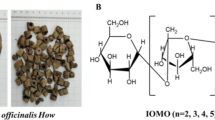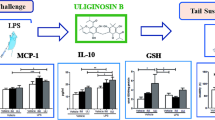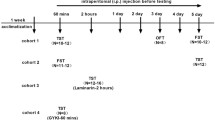Abstract
Lectins are proteins capable of reversible binding to the carbohydrates in glycoconjugates that can regulate many physiological and pathological events. Galectin-1, a β-galactoside-binding lectin, is expressed in the central nervous system (CNS) and exhibits neuroprotective functions. Additionally, lectins isolated from plants have demonstrated beneficial action in the CNS. One example is a lectin with mannose-glucose affinity purified from Canavalia brasiliensis seeds, ConBr, which displays neuroprotective and antidepressant activity. On the other hand, the effects of the galactose-binding lectin isolated from Vatairea macrocarpa seeds (VML) on the CNS are largely unknown. The aim of this study was to verify if VML is able to alter neural function by evaluating signaling enzymes, glial and inflammatory proteins in adult mice hippocampus, as well as behavioral parameters. VML administered by intracerebroventricular (i.c.v) route increased the immobility time in the forced swimming test (FST) 60 min after its injection through a carbohydrate recognition domain-dependent mechanism. Furthermore, under the same conditions, VML caused an enhancement of COX-2, GFAP and S100B levels in mouse hippocampus. However, phosphorylation of Akt, GSK-3β and mitogen-activated protein kinases named ERK1/2, JNK1/2/3 and p38MAPK, was not changed by VML. The results reported here suggest that VML may trigger neuroinflammatory response in mouse hippocampus and exhibit a depressive-like activity. Taken together, our findings indicate a dual role for galactose binding lectins in the modulation of CNS function.





Similar content being viewed by others
Abbreviations
- ANOVA:
-
Analysis of variance
- BDNF:
-
Brain derived neurotrophic factor
- CNS:
-
Central nervous system
- ConA:
-
Concanavalin A
- COX:
-
Cyclooxygenase
- CRD:
-
Carbohydrate recognition domain
- ELISA:
-
Enzyme-linked immunosorbent assay
- ERK:
-
Extracellular signal-regulated kinases
- FST:
-
Forced swimming test
- Gal-1:
-
Galectin-1
- GFAP:
-
Glial fibrillary acid protein
- GSK:
-
Glycogen synthase kinase
- JNK:
-
c-jun amino-terminal kinase
- MAPK:
-
Mitogen-activated protein kinase
- TNF-α:
-
Tumor necrosis factor
References
Kleene R, Schachner M (2004) Glycans and neural cell interactions. Nat Rev Neurosci 5:195–208
Ishii A, Ikeda T, Hitoshi S, Fujimoto I, Torii T, Sakuma K, Nakakita S, Hase S, Ikenaka K (2007) Developmental changes in the expression of glycogenes and the content of N-glycans in the mouse cerebral cortex. Glycobiology 17:261–276
Dube DH, Bertozzi CR (2005) Glycans in cancer and inflammation potential for therapeutics and diagnostics. Nat Rev Drug Discov 4:477–488
Liu F-T, Rabinovich GA (2005) Galectins as modulators of tumour progression. Nat Rev Cancer 5:29–41
Marschal P, Reeber A, Neeser J-R, Vincendon G, Zanetta J-P (1989) Carbohydrate and glycoprotein specificity of two endogenous cerebellar lectins. Biochimie 71:645–653
Almkvist J, Karlsson A (2004) Galectins as inflammatory mediators. Glycoconj J 19:575–581
Endo T (2005) Glycans and glycan-binding proteins in brain: galectin-1-induced expression of neurotrophic factors in astrocytes. Curr Drug Targets 6:427–436
Lekishvili T, Hesketh S, Brazier MW, Brown DR (2006) Mouse galectin-1 inhibits the toxicity of glutamate by modifying NR1 NMDA receptor expression. Eur J Neurosci 24:3017–3025
Sakaguchi M, Imaizumi Y, Okano H (2007) Expression and function of galectin-1 in adult neural stem cells. Cell Mol Life Sci 64:1254–1258
Dani N, Broadie K (2012) Glycosylated synaptomatrix regulation of trans-synaptic signaling. Dev Neurobiol 72:2–21
Barondes SH, Castronovo V, Cooper DN, Cummings RD, Drickamer K, Feizi T, Gitt MA, Hirabayashi J, Hughes C, Kasai K (1994) Galectins: a family of animal beta-galactoside-binding lectins. Cell 76:597–598
Sakaguchi M, Shingo T, Shimazaki T, Okano HJ, Shiwa M, Ishibashi S, Oguro H, Ninomiya M, Kadoya T, Horie H (2006) A carbohydrate-binding protein, Galectin-1, promotes proliferation of adult neural stem cells. Proc Natl Acad Sci USA 103:7112–7117
Ishibashi S, Kuroiwa T, Sakaguchi M, Sun L, Kadoya T, Okano H, Mizusawa H (2007) Galectin-1 regulates neurogenesis in the subventricular zone and promotes functional recovery after stroke. Exp Neurol 207:302–313
Qu WS, Wang YH, Wang JP, Tang YX, Zhang Q, Tian DS, Yu ZY, Xie MJ, Wang W (2010) Galectin-1 enhances astrocytic BDNF production and improves functional outcome in rats following ischemia. Neurochem Res 35:1716–1724
Qu W-S, Wang Y-H, Ma J-F, Tian D-S, Zhang Q, Pan D-J, Yu Z-Y, Xie M-J, Wang J-P, Wang W (2011) Galectin-1 attenuates astrogliosis-associated injuries and improves recovery of rats following focal cerebral ischemia. J Neurochem 116:217–226
Sasaki T, Hirabayashi J, Manya H, Kasai K, Endo T (2004) Galectin-1 induces astrocyte differentiation, which leads to production of brain-derived neurotrophic factor. Glycobiology 14:357–363
Sakaguchi M, Arruda-Carvalho M, Kang NH, Imaizumi Y, Poirier F, Okano H, Frankland P (2011) Impaired spatial and contextual memory formation in galectin-1 deficient mice. Mol Brain 4:33
Starossom SC, Mascanfroni ID, Imitola J, Cao L, Raddassi K, Hernandez SF, Bassil R, Croci DO, Cerliani JP, Delacour D, Wang Y, Elyaman W, Khoury SJ, Rabinovich GA (2012) Galectin-1 deactivates classically activated microglia and protects from inflammation-induced neurodegeneration. Immunity 37:249–263
Cavada BS, Barbosa T, Arruda S, Grangeiro TB, Barral-Netto M (2001) Revisiting proteus: do minor changes in lectin structure matter in biological activity? Lessons from and potential biotechnological uses of the Diocleinae subtribe lectins. Curr Protein Pept Sci 2:123–135
Fay A-ML, Bowie D (2006) Concanavalin-A reports agonist-induced conformational changes in the intact GluR6 kainate receptor. J Physiol. 572:201–213
Lin SS, Levitan IB (1991) Concanavalin a: a tool to investigate neuronal plasticity. Trends Neurosci. 14:273–277
Scherer WJ, Udin SB (1994) Concanavalin A reduces habituation in the tectum of the frog. Brain Res. 667:209–215
Partin KM, Patneau DK, Winters CA, Mayer ML, Buonanno A (1993) Selective modulation of desensitization at AMPA versus kainate receptors by cyclothiazide and concanavalin A. Neuron 11:1069–1082
Boehm S, Huck S (1998) Presynaptic inhibition by concanavalin A: Are α-latrotoxin receptors involved in action potential-dependent transmitter release? J Neurochem 71:2421–2430
Cedeño N, Urbina M, Obregón F, Lima L (2005) Characterization of serotonin transporter in blood lymphocytes of rats. Modulation by in vivo administration of mitogens. J Neuroimmunol 159:31–40
Russi MA, Vandresen-Filho S, Rieger DK, Costa AP, Lopes MW, Cunha RM, Teixeira EH, Nascimento KS, Cavada BS, Tasca CI, Leal RB (2012) ConBr, a Lectin from Canavalia brasiliensis seeds, protects against quinolinic acid-induced seizures in mice. Neurochem Res 37:288–297
Barauna SC, Kaster MP, Heckert BT, do Nascimento KS, Rossi FM, Teixeira EH, Cavada BS, Rodrigues ALS, Leal RB (2006) Antidepressant-like effect of lectin from Canavalia brasiliensis (ConBr) administered centrally in mice. Pharmacol Biochem Behav 85:160–169
Jacques AV, Rieger DK, Maestri M, Lopes MW, Peres TV, Gonçalves FM, Pedro DZ, Tasca CI, López MG, Egea J, Nascimento KS, Cavada BS, Leal RB (2013) Lectin from Canavalia brasiliensis (ConBr) protects hippocampal slices against glutamate neurotoxicity in a manner dependent of PI3 K/Akt pathway. Neurochem Int 62:836–842
Ramos MV, Bomfim LR, Cavada BS, Alencar NMN, Grangeiro TB, Debray H (2000) Further characterization of the glycan-binding specificity of the seed lectin from Vatairea macrocarpa and its dependence of pH. Prot Pept Lett 7:241–248
Alencar NMM, Assreuy AMS, Criddle DN, Souza P, Soares PMG, Havt A, Aragão KS, Bezerra DP, Ribeiro RA, Cavada BS (2004) Vatairea macrocarpa lectin induces paw edema with leucocyte infiltration. Protein Pept Lett 11:1–6
Alencar NM, Assreuy AM, Alencar VB, Melo SC, Ramos MV, Cavada BS, Cunha FQ, Ribeiro RA (2003) The galactose-binding lectin from Vatairea macrocarpa seeds induces in vivo neutrophil migration by indirect mechanism. Int J Biochem Cell Biol. 35:1674–1681
Alencar NMN, Assreuy MAS, Havt A, Benevides RG, Moura TR, Sousa RB, Ribeiro RA, Cunha FQ, Cavada BS (2007) Vatairea macrocarpa (Leguminosae) lectin activates cultured macrophages to release chemotactic mediators. Naunyn Schmiedebergs Arch Pharmacol 374:275–282
Loftis JM, Huckans M, Morasco BJ (2010) Neuroimmune mechanisms of cytokine-induced depression: current theories and novel treatment strategies. Neurobiol Dis 37:519–533
Steiner J, Bogerts B, Schroeter ML, Bernstein HG (2011) S100B protein in neurodegenerative disorders. Clin Chem Lab Med 49:409–424
Costa AP, Tramontina AC, Biasibetti R, Batassini C, Lopes MW, Wartchow KM, Bernardi C, Tortorelli LS, Leal RB, Gonçalves CA (2012) Neuroglial alterations in rats submitted to the okadaic acid-induced model of dementia. Behav Brain Res 226:420–427
Eng LF, Ghirnikar RS, Lee YL (2000) Glial fibrillary acidic protein: GFAP-thirty-one years (1969–2000). Neurochem Res 25:1439–1451
Gonçalves CA, Leite MC, Nardin P (2008) Biological and methodological features of the measurement of S100B, a putative marker of brain injury. Clin Biochem 41:755–763
Donato R, Sorci G, Riuzzi F, Arcuri C, Bianchi R, Brozzi F, Tubaro C, Giambanco I (2009) S100B’s double life: intracellular regulator and extracellular signal. Biochim Biophys Acta 1793:1008–1022
Seibert K, Masferrer J, Zhang Y, Gregory S, Olson G, Hauser S, Leahy K, Perkins W, Isakson P (1995) Mediation of inflammation by cyclooxygenase-2. Agents Actions Suppl 46:41–50
O’Banion MK (1999) Cyclooxygenase-2: molecular biology, pharmacology, and neurobiology. Crit Rev Neurobiol 13:45–82
Akhondzadeh S, Jafari S, Raisi F, Nasehi AA, Ghoreishi A, Salehi B, Mohebbi-Rasa S, Raznahan M, Kamalipour A (2009) Clinical trial of adjunctive celecoxibtreatment in patients with major depression: a double blind and placebo controlled trial. Depress Anxiety 26:607–611
Murray HJ, O’Connor JJ (2003) A role for COX-2 and p38 mitogen activated protein kinase in long-term depression in the rat dentate gyrus in vitro. Neuropharmacology 44:374–380
Su HC, Ma CT, Yu BC, Chien YC, Tsai CC, Huang WC, Lin CF, Chuang YH, Young KC, Wang JN, Tsao CW (2012) Glycogen synthase kinase-3β regulates anti-inflammatory property of fluoxetine. Int Immunopharmacol 14:150–156
Bento CA, Cavada BS, Oliveira JT, Moreira CAM, Barja-Fidalgo C (1993) Rat paw edema and leukocyte immigration induced by plant lectins. Agents Actions 38:48–54
Calvete JJ, Santos CF, Mann K, Grangeiro TB, Nimtnz N, Cavada BS (1998) Primary structure and post-translational processing of Vatairea macrocarpa seed lectin. J Protein Chem 17:545–547
Calvete JJ, Santos CF, Mann K, Grangeiro TB, Nimtz M, Urbanke C, Sousa-Cavada B (1998) Amino acid sequence, glycan structure, and proteolytic processing of the lectin of Vatairea macrocarpa seeds. FEBS Letters 425:286–292
Cavada BS, Santos CF, Grangeiro TB, Nunes EP, Sales PVP, Ramos RL, De Sousa FAM, Crisostomo CV, Calvete JJ (1998) Purification and characterization of a lectin from seeds of Vatairea macrocarpa duke. Phytochemistry 49:675–680
Brocardo P de S, Budni J, Lobato KR, Kaster MP, Rodrigues ALS (2008) Antidepressant-like effect of folic acid: involvement of NMDA receptors and l-arginine-nitric oxide-cyclic guanosine monophosphate pathway. Eur J Pharmacol 598:37–42
Kaster MP, Gadotti VM, Calixto JB, Santos ARS, Rodrigues ALS (2012) Depressive-like behavior induced by tumor necrosis factor-α in mice. Neuropharmacology 62:419–426
Budni J, Gadotti VM, Kaster MP, Santos ARS, Rodrigues ALS (2007) Role of different types of potassium channels in the antidepressant-like effect of agmatine in the mouse forced swimming test. Eur J Pharmacol 575:87–93
Freitas AE, Budni J, Lobato KR, Binfaré RW, Machado DG, Jacinto J, Veronezi PO, Pizzolatti MG, Rodrigues ALS (2010) Antidepressant-like action of the ethanolic extract from Tabebuia avellanedae in mice: evidence for the involvement of the monoaminergic system. Prog Neuropsychopharmacol Biol Psychiatry 34:335–343
Budni J, Zomkowski AD, Engel D, Santos DB, dos Santos AA, Moretti M, Valvassori SS, Ornell F, Quevedo J, Farina M, Rodrigues AL (2013) Folic acid prevents depressive-like behavior and hippocampal antioxidant imbalance induced by restraint stress in mice. Exp Neurol 240:112–121
Porsolt RD, Bertin A, Jalfre M (1977) Behavioral despair in mice: a primary screening test for antidepressants. Arch Int Pharmacodyn Ther 229:327–336
Lopes MW, Mahatma FSS, Mello N, Nunes JC, Cordova FM, Walz R, Leal RB (2012) Time-dependent modulation of mitogen activated protein kinases and AKT in rat hippocampus and cortex in the pilocarpine model of epilepsy. Neurochem Res 37:1868–1878
Peterson GL (1977) A simplification of the protein assay method of Lowry et al. which is more generally applicable. Anal Biochem 83:346–356
Leite MC, Galland F, Brolese G, Guerra MC, Bortolotto JW, Freitas R, de Almeida LMV, Gottfried C, Gonçalves C-A (2008) A simple, sensitive and widely applicable ELISA for S100B: methodological features of the measurement of this glial protein. J Neurosci Methods 169:93–99
Tramontina F, Leite MC, Cereser K, De Souza DF, Tramontina AC, Nardin P, Andreazza AC, Gottfried C, Kapczinski F, Gonçalves C-A (2007) Immunoassay for glial fibrillary acidic protein: antigen recognition is affected by its phosphorylation state. J Neurosci Methods 162:282–286
Cryan JF, Hoyer D, Markou A (2003) Withdrawal from chronic amphetamine induces Depressive-Like behavioral effects in rodents. Biol Psychiatry 54:49–58
O’Reilly KC, Shumake J, Gonzalez-Lima F, Lane MA, Bailey SJ (2006) Chronic administration of 13-Cis-retinoic acid increases depression-related behavior in mice. Neuropsychopharmacology 31:1919–1927
Brocardo PS, Assini F, Franco JL, Pandolfo P, Müller YMR, Takahashi RN, Dafre AL, Rodrigues ALS (2007) Zinc attenuates malathion-induced depressant-like behavior and confers neuroprotection in the rat brain. ToxicolSci 97:140–148
Borre Y, Lemstra S, Westphal KGC, Morgan ME, Olivier B, Oosting RS (2012) Celecoxib delays cognitive decline in an animal model of neurodegeneration. Behav Brain Res 234:285–291
Madrigal JLM, Moro MA, Lizasoain I, Lorenzo P, Fernandez AP, Rodrigo J, Bosca L, Leza JC (2003) Induction of cyclooxygenase-2 accounts for restraint stress-induced oxidative status in rat brain. Neuropsychopharmacology 28:1579–1588
Cassano P, Hidalgo A, Burgos V, Adris S, Argibay P (2006) Hippocampal upregulation of the cyclooxygenase-2 gene following neonatal clomipramine treatment (a model of depression). Pharmacogenomics J 6:381–387
Li Y-C, Shen J-D, Li J, Wang R, Jiao S, Yi L-T (2013) Chronic treatment with baicalin prevents the chronic mild stress-induced depressive-like behavior: involving the inhibition of cyclooxygenase-2 in rat brain. Prog Neuropsychopharmacol Biol Psychiatry 40:138–143
Johansson D, Falk A, Marcus MM, Svensson TH (2012) Celecoxib enhances the effect of reboxetine and fluoxetine on cortical noradrenaline and serotonin output in the rat. Prog Neuropsychopharmacol Biol Psychiatry 39:143–148
Sofroniew MV (2009) Molecular dissection of reactive astrogliosis and glial scar formation. Trends Neurosci 32:638–647
Ye Y, Wang G, Wang H, Wang X (2011) Brain-derived neurotrophic factor (BDNF) infusion restored astrocytic plasticity in the hippocampus of a rat model of depression. Neurosci Lett 503:15–19
Falcone T, Fazio V, Lee C, Simon B, Franco K et al (2010) Serum S100B: a potential biomarker for suicidality in adolescents? PLoS ONE 5:e11089
Schroeter ML, Steiner J, Mueller K (2011) Glial pathology is modified by age in mood disorders: a systematic meta-analysis of serum S100B in vivo studies. J Affect Disord 134:32–38
Thomas GM, Huganir RL (2004) MAPK cascade signalling and synaptic plasticity. Nat Rev Neurosci 5:173–183
Kim EK, Choi E-J (2010) Pathological roles of MAPK signaling pathways in human diseases. Biochim Biophys Acta 1802:396–405
Galeotti N, Ghelardini C (2011) Regionally selective activation and differential regulation of ERK, JNK and p38 MAP kinase signalling pathway by protein kinase C in mood modulation. Int J Neuropsychopharmacol 15:781–793
Beaulieu JM (2007) Not only lithium: regulation of glycogen synthase kinase-3 by antipsychotics and serotonergic drugs. Int J Neuropsychopharmacol 10:3–6
Beaulieu JM, Gainetdinov RR, Caron MG (2009) Akt/GSK3 signaling in the action of psychotropic drugs. Annu Rev Pharmacol Toxicol 49:327–437
Acknowledgments
This work was supported by the Conselho Nacional de Desenvolvimento Científico e Tecnológico (CNPq) Brazil (#305194/2010-0); Coordenação de Aperfeiçoamento de Pessoal de Nível Superior (CAPES)/PROCAD and CAPES/DGU 173/2008; National Institute of Science and Technology (INCT) for Excitotoxicity and Neuroprotection; Fundação de Amparo a Pesquisa de Santa Catarina (FAPESC); FAPESC/PRONEX—Núcleo de Excelência em Neurociências Aplicadas de Santa Catarina (NENASC); IBN.Net/CNPq. A.S.L.R., C.A.S.G., E. H.T., K.S.N., B.S.C. and R.B.L. are recipientes of research scholarships from CNPq. The funding agencies had no role in study design, data collection and analysis, decision to publish, or preparation of the manuscript.
Conflict of interest
The authors declare that they have no conflict of interest.
Author information
Authors and Affiliations
Corresponding author
Rights and permissions
About this article
Cite this article
Gonçalves, F.M., Freitas, A.E., Peres, T.V. et al. Vatairea macrocarpa Lectin (VML) Induces Depressive-like Behavior and Expression of Neuroinflammatory Markers in Mice. Neurochem Res 38, 2375–2384 (2013). https://doi.org/10.1007/s11064-013-1150-9
Received:
Revised:
Accepted:
Published:
Issue Date:
DOI: https://doi.org/10.1007/s11064-013-1150-9




